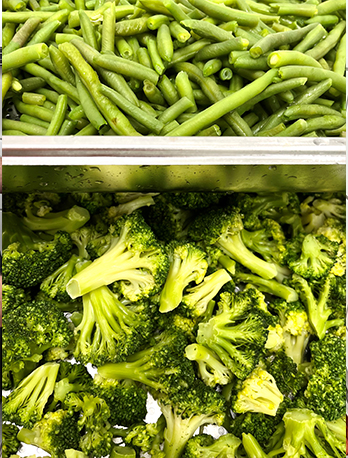We use cookies to improve your online experiences. To learn more and choose your cookies options, please refer to our cookie policy.

Our school places great emphasis on cultivating healthy eating habits for all age groups. Therefore, our salad bar features fresh seasonal vegetables every day, with the selection regularly updated to ensure that popular salads like yogurt beetroot salad, homemade pesto mozzarella salad, and Greek salad remain part of our offerings.
In the past five school days, our school has consumed 30 kg of carrots, 40 kg of cucumbers, 40 kg of regular tomatoes, 5 kg of cherry tomatoes, 15 kg of mixed lettuce (including arugula, iceberg, and lolo rosso), 10 kg of mushrooms, 15 kg of bell peppers, 10 kg of beets, 10 kg of celery, and various other vegetables, such as garlic, spring onions, English celery, cabbage, sweet potatoes, parsley, and chives.
Following healthy eating recommendations, it is essential to consume at least three servings of vegetables daily for the proper functioning of our bodies. Catering regulations suggest a daily consumption range for fresh vegetables: 20-70 grams for preschoolers, 40-100 grams for elementary school students, and 80-150 grams for high school students and adults. Vegetables are rich in vitamins and minerals, providing a significant amount of fiber. Proper storage of vegetables is crucial, as the ripening process continues during transportation and storage. When purchasing vegetables, it is important to consider when they will be used.
Did you know, for example, that carrots can suffer from frost damage in the refrigerator? Or that bananas brown faster in the fridge? Perhaps you're aware that plums ripen more quickly when in the company of bananas.
Next week, we will provide insight into our school's fruit consumption habits. Until then, we'd like to share one of our favorite salad recipes with you.
The Mozzarella salad with homemade pesto is one of the most popular dishes in our salad bar. The pesto is made in our kitchen and doesn’t contain any seeds. This version gives a lighter flavor that livens up the salad.
Nut-free pesto recipe
Ingredients
70 g fresh basil leaves
40 g grated pecorino or parmesan cheese
40 ml extra virgin olive oil
pinch salt and white pepper
Three cloves garlic
Instructions
Combine the ingredients in a food processor and pulse until smooth.
Suppose you prefer to make your pesto by hand, the traditional Italian way. In that case, you need a large pestle and mortar, too. The point of using the pestle and mortar is that you are much more in control of how your pesto is prepared. The texture of a hand-prepared pesto is quite different.
If you do it this way, you need to follow these steps.
Tear the basil into smallish shreds.
Put the peeled garlic cloves in a pestle and mortar with the salt and crush until you have a paste.
Add the basil leaves in batches, crushing with the pestle until all the leaves are well blended with the garlic and salt, and you have a paste.
Add the grated cheese and mix.
Now pour over a little olive oil and blend well, using the base of the pestle.
Add olive oil until you have a thick 'sauce' of the desired consistency.
You can use the pesto in so many ways. For example, it can be served with summer pasta dishes, a topping for a homemade burger, tomato bakes or a sauce to bake chicken/fish in the oven.
You should try the pestle and mortar way at least once because your pesto will have more depth of flavor and a better texture.
If you have leftover pesto, keep it in the fridge for a week. But you can quickly freeze it in an ice-cube tray, too. Once the pesto is frozen, all you need to do is pop the cubes out and into a zip-lock bag and have a convenient supply of individual portions of nut-free pesto. It can be stored in the freezer for up to 6 months.
There are so many varieties of nut-free pesto.
You can add spinach leaves, sun-dried tomato, or fresh herbs - try another herb instead of the basil, like oregano or parsley. Oregano pesto with Feta cheese has such a unique taste.
You can also try it with vegan cheese so that it can be dairy-free as well.